Solar energy is green, free to collect, and once you set it up, it can provide most (or even all) of your RV’s power needs. Follow along to learn about RV solar panels and which ones are the right choice for you and your rig.
- 1) What Are RV Solar Panels?
- 2) How Much Does an RV Solar Setup Cost?
- 3) How Many Solar Panels Do I Need For My RV?
- 4) Types of RV Solar Panels
- 5) Rigid vs. Flexible RV Solar Panels
- 6) Portable RV Solar Panels vs. Roof-Mounted
- 7) Benefits of Installing Solar on an RV
- 8) Additional Components Necessary for an RV Solar System
- 9) Are RV Solar Panels Worth It?
What Are RV Solar Panels?
RV solar panels collect sunlight in their cells and turn it into energy that can be stored. The panels produce DC (direct current), which is managed by a charge controller and stored in a battery bank, like a rechargeable lithium battery.
An inverter can then convert the DC electricity into AC (alternating current), which we use to run things like household appliances. You usually mount the panels on the RV’s roof, but they can also be free-standing.
How Much Does an RV Solar Setup Cost?
Since most RVs don’t come with solar panels pre-installed, it’s typically an aftermarket project, which can be performed by a professional… or a confident, capable DIY RVer. We installed our system ourselves with an assist from friends.
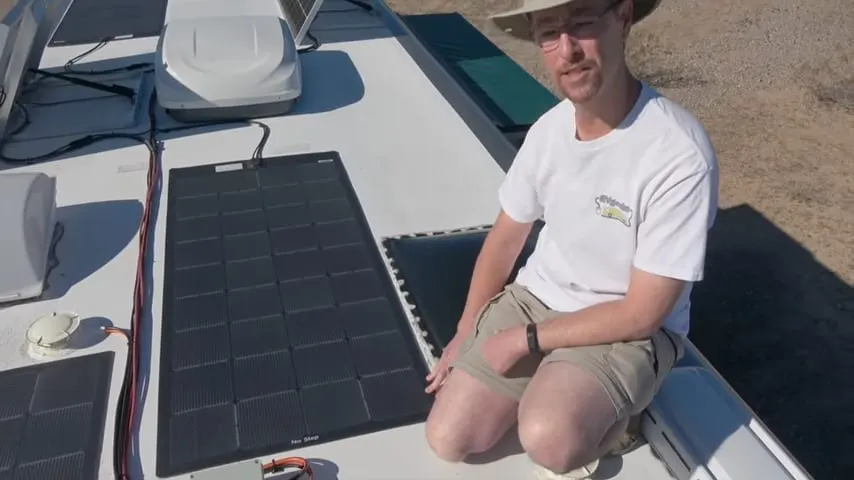
Our Class A RV’s large roof provides space for 1,300 Watts of solar panels with plenty of room to spare.
Your power demand will determine how many solar panels and batteries you’ll need. If you want to be able to use many electric appliances when you’re off the grid, you’ll need a more extensive setup, especially if your RV has a residential refrigerator.
A basic solar system could cost about $600, but costs can reach $3,500 and beyond depending on your needs. A basic system could be as simple as using one battery and a single, portable folding solar panel. This should be enough to run one or two smaller items at a time.
With a very extensive system, you could add enough solar panels to the roof of your RV to provide sufficient solar energy to run an air conditioner, refrigerator, and various personal devices. Depending on the system (and accompanying battery bank), you may or may not be able to run them all at the same time, or for very long.
How Many Solar Panels Do I Need For My RV?
The number of solar panels you’ll need depends on electrical usage within the RV, your battery bank size, and what you want to do at any given time. The more solar panels you have, the more energy you can create, given the availability of the sun. Keep in mind that you can only generate as much power as you have the battery capacity to store it.
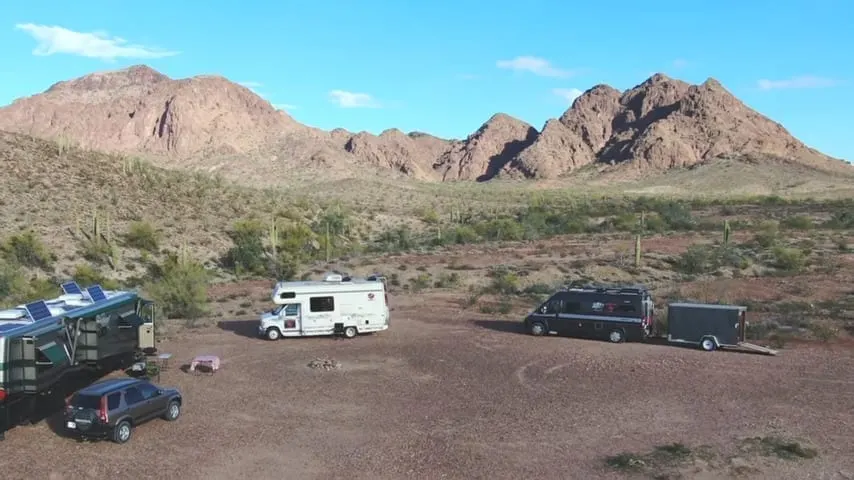
How many solar panels you can have on your RV depends, in large part, on the size of your RV.
The size of your rig is a good indicator of how many panels you’ll need as well. A small travel trailer with an RV refrigerator and a few lights will require fewer solar panels than a large class A with a residential refrigerator and a larger battery bank to re-charge.
There are many calculators and solar panel guides available online to help you to calculate your power needs, which is typically referred to as “performing a power audit.”
Basically, a “power audit” is where you add up all of the power you use during a typical day of RVing, multiplying the amp draw of a device by the amount of time it’s typically run to get the amp-hour power usage. Once you’ve totaled all of the amp-hours of power needed in a day, the general rule of thumb is to multiply that by 2-2.5 to determine the amount of watts of solar you’ll need to supply that amount of power each day. So, if your audit shows that you use 100 amp-hours of power per day, you’d want to install a minimum of 200 to 250 Watts of solar.
Types of RV Solar Panels
There are two basic types of solar panel technologies you need to know about: monocrystalline and polycrystalline. Each has its perks and drawbacks, so consider what’s most important to you before buying.
Monocrystalline
Monocrystalline solar panels, or single-silicon crystal panels, are a design that generally has more ability to collect solar energy than its counterpart. Monocrystalline panels are more efficient and generate more power per square foot. However, they also carry a heftier price tag because they’re more expensive to produce.
Polycrystalline
Polycrystalline panels contain many small crystals. These panels are recognizable by their blue cast. Their lower price makes them a less expensive way to get into solar (although the price gap is closing). They have many crystals in each layer, which makes them less efficient than their monocrystalline counterparts.
Rigid vs. Flexible RV Solar Panels
Choosing between rigid panels and flexible panels is a new challenge in the RV world. Flexible panels can often be less expensive than, but still produce as much energy as, rigid panels. Flexible panels are typically less robust than rigid panels, so they’re likely to have a shorter lifespan (although newer entrants in the flexible market are addressing some of those issues… like the 165W Xantrex Flex Max panels that we installed, which are more robust than any other we’ve seen on the market).
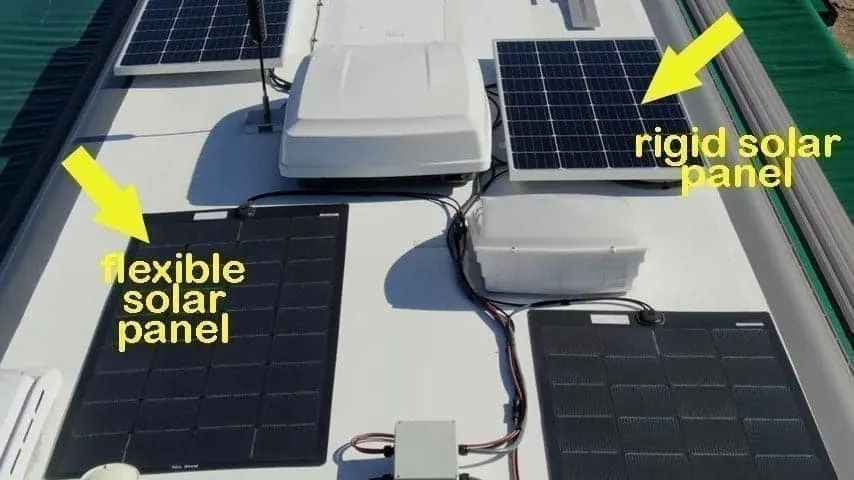
We use a combination of rigid and flexible solar panels on our RV.
While both types of panels create heat as they work, flexible panels are in direct contact with the roof. This can be an issue during the summer when heat transfer can increase your RV’s interior temperature. That buildup of heat beneath the panel can also reduce the flexible panel’s output, shorten their lifespan, and potentially damage the adhesion of a rubber (EPDM or TPO) roof membrane.
Rigid RV solar panels are more durable, so they handle the stress of travel better over time. You can also tilt them to face the sun or clean underneath them. This can provide practical benefits for easy roof maintenance (although flexible panels don’t generally require cleaning underneath them, since they adhere directly to the roof). And because rigid panels are generally mounted so there’s a gap between them and your RV’s roof, airflow can help to cool them and improve their efficiency (plus the gap minimizes/prevents the transfer of that heat into/through your roof).
Read more about our solar upgrade project.
Two of the biggest benefits to flexible panels are the ease of installation (peel & stick), and the accompanying lack of screw holes (leak potential) into the roof structure. But they also have a weight advantage (helpful if your RV has limited carrying capacity) and can be installed more easily on curved roofs (Airstream anyone?).
The biggest drawbacks to rigid RV solar panels are that they generally require screwing into the roof to install them, and they weigh more than flexible panels. These factors may not be an issue in every case, as larger RVs often have fiberglass roofs, which provides the option of using strong adhesive tape (3M VHB tape is an excellent choice) for mounting them instead of screws. And, if you’re hesitant to drill new holes in your RV’s roof, you can always opt to allow a professional to do the installation for you.
Large RVs also tend to have considerably higher maximum weight ratings, so the extra weight of many rigid solar panels may not be a factor.
Since rigid solar panels are the type used on traditional solar farms, you can be confident in their ability to handle the elements and last a very long time.
Portable RV Solar Panels vs. Roof-Mounted
Up to this point, we’ve been discussing permanently-installed solar options. But you could instead decide to use portable (often called “Ground Deploy”) panels, instead. There are pros and cons to each, so it’s all about determining what’s best for your application.
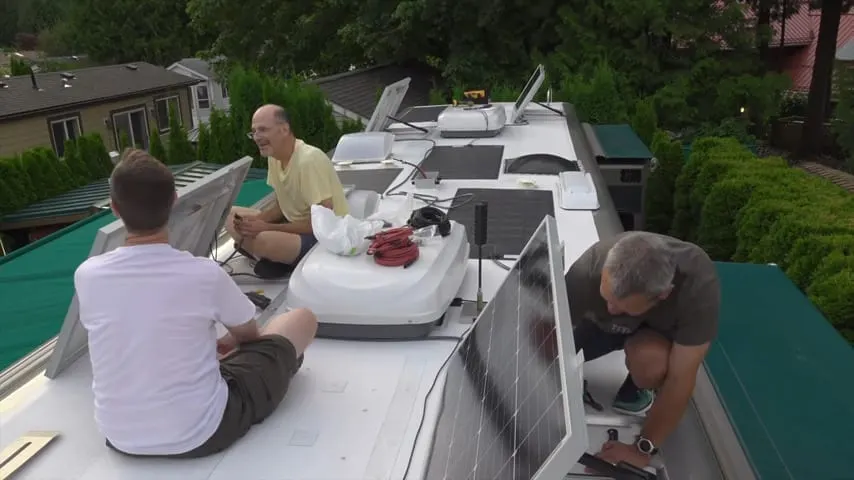
Installing rigid solar panels on your RV’s roof usually involves creating holes in your RV. You can do it yourself, or you can hire a professional.
Portable RV solar panels can be taken with you if you decide to tent camp for the weekend or even if you sell your RV. Usually, these mobile systems include solar panels, charge controllers, and the required cables, all in lightweight packages.
A portable system can also be moved and aimed. That’s especially handy when your RV is parked under a tree, or you want to aim them more directly toward the sun at various times of the day to maximize their output. Portables are also excellent systems for backup situations or emergencies.
On the downside, you have to set up portable panels every time you move or need to use them. And you have to have a place where you can safely store them when not in use. Because of their portability, you have to factor in that they have a higher risk of theft.
Roof-mounted panels are durable and can cost about the same, if not less than, a portable unit per watt of energy. But they have the added cost (or effort, if going DIY) of installation.
Benefits of Installing Solar on an RV
The benefits of having RV solar panels on your rig begin with the freedom to camp where and when you want without being tethered to electricity, and without having to run a generator very often, or at all. You’ll have to make an initial investment, but it won’t be long before you can count the savings.
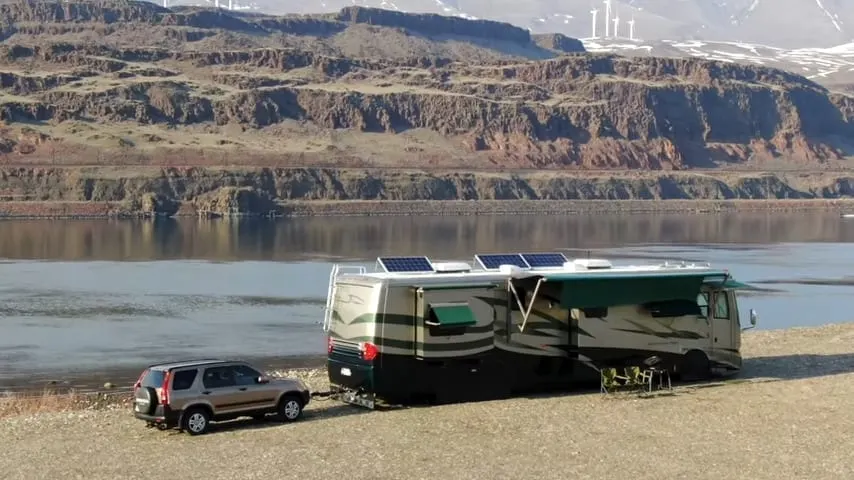
Even our original 3-panel RV solar system allowed us to boondock in some seriously beautiful places!
Solar panels can allow you to maximize your time boondocking (camping without hookups), which can enable you to recoup your investment more quickly reducing the expense of staying at RV parks and campgrounds.
Solar power is also silent (unlike a generator) and has no emissions (again, unlike a generator), enabling you to enjoy more of the peace & quiet and the clean, fresh air you likely wanted to experience when you bought your RV.
Additional Components Necessary for an RV Solar System
In addition to solar panels, you’ll need a charge controller (or a couple of charge controllers, depending on the size of your solar array) to properly manage the output of the panels.
Solar systems also require a battery bank to store the power they generate. If you’re going to the time, energy, and cost of installing solar on your RV, you’ll most likely want to maximize your battery bank. Due to their capacity, lower maintenance requirements, and ease of charging, many people are opting to upgrade their batteries to lithium.
Are RV Solar Panels Worth It?
It all comes down to the type of RVer you are. Do you enjoy camping for the social aspect and welcome the amenities an RV resort can offer? If so, you might not need solar, and the cost might not be worthwhile for you.
However, if you enjoy boondocking (camping without hookups) as we do, then solar could be the best way to charge your batteries and give you almost unlimited electricity on the road, while maintaining the peace and quiet that generators can interrupt.
If you don’t have a generator, solar can be a lifesaver when you’re camping off the grid.
RV solar panels are definitely worth exploring… we know we love the freedom that ours provide, and think you will, too.
Geek Out with Us Every Week
Join our newsletter to learn about all things RV-related. Every week we offer free tips, tricks, product reviews, and more to our online community of RVers. Whether this is your first time on the road or you’re a seasoned expert, we’d love for you to geek out with us!


Richard Hubert
Saturday 20th of March 2021
Good discussion on solar panels.
But, as mentioned, I think it is much more important for the RV to be equipped with a strong, robust battery system first. Not only does this system require the largest investment, but it is quite useful even without solar as it can be charged up by other methods.
You guys know all this! I have seen your past posts on this subject as well as your videos on upgrading your own rig. And I totally agree that the best battery systems will incorporate LiFePO4 batteries as these make such a difference over Lead Acid batteries.
Once one has invested in a good Lithium battery system for their RV, it is relatively inexpensive to then add solar panels and solar controller.
So when asked I always recommend that the batteries be upgraded 1st especially if one can afford Lithium.
JOHN SCHRETLEN
Friday 19th of March 2021
There should be an award for the best solar setup on an RV. You'd #1 for sure. (Unless the Morton's enter the contest and then you might be pushed to #2.)
When reading about covering the California canals with solar panels I learned something: "Ironically enough, the performance of solar panels falls as temperatures rise. In a solar cell, photons from the sun knock electrons out of atoms, producing an electric current. When a panel gets too hot, that puts electrons into an already excited state, so they don’t create as much energy when dislodged by photons."
Link: https://www.wired.com/story/why-covering-canals-with-solar-panels-is-a-power-move/
After reading this I'm thinking that cooler non-tilting panels might be very close to the efficiency of hot tilting ones in desert climates. Your thoughts?
TheRVgeeks
Friday 19th of March 2021
You're no slouch in the solar department, yourself, John! ???? And good question about the cool-non-tilting- vs hot-tilted- panels question. Not sure we can answer that, as they didn't indicate what the % increase in performance was from keeping them cool. But we CAN tell you that tilting in the desert SW can provide between a 30-40% increase in output. Depending on the time of year, angle of the sun, and the outside temp (which, of course, is cooler in the winter months when tilting is needed... by mid-to-late March, the sun is already high enough that tilting isn't needed).